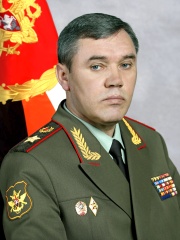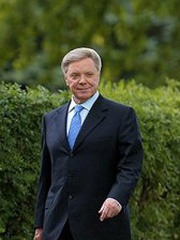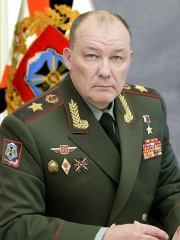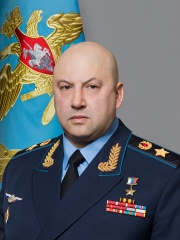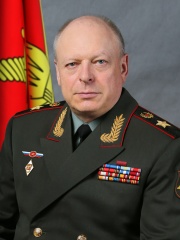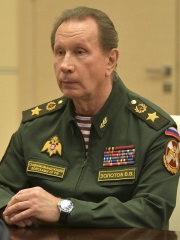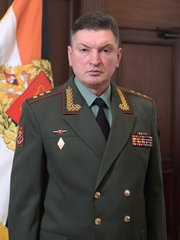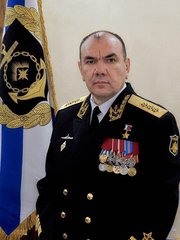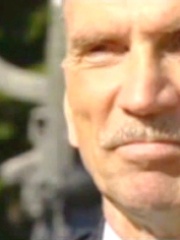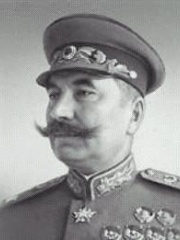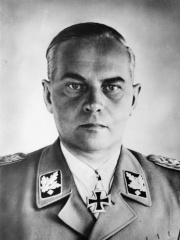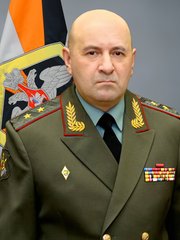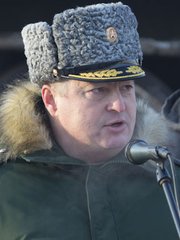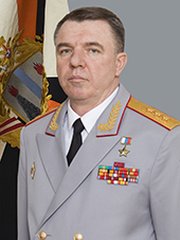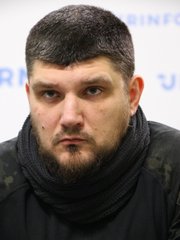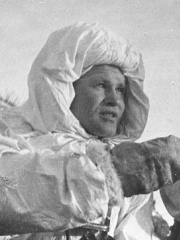
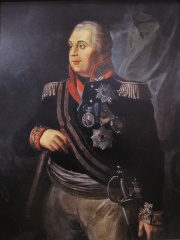
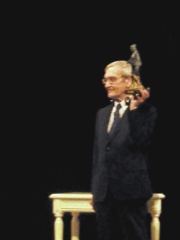
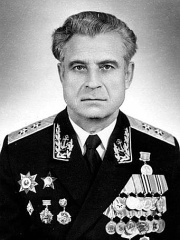
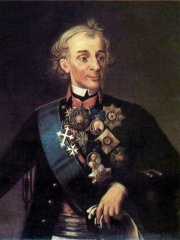
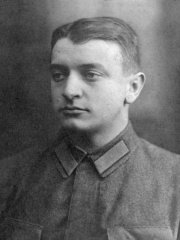
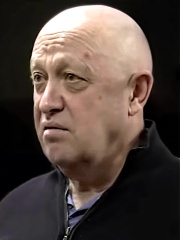
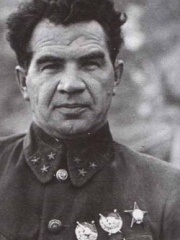
The Most Famous
MILITARY PERSONNELS from Russia
This page contains a list of the greatest Russian Military Personnels. The pantheon dataset contains 2,058 Military Personnels, 168 of which were born in Russia. This makes Russia the birth place of the 3rd most number of Military Personnels behind Germany, and United States.
Top 10
The following people are considered by Pantheon to be the top 10 most legendary Russian Military Personnels of all time. This list of famous Russian Military Personnels is sorted by HPI (Historical Popularity Index), a metric that aggregates information on a biography's online popularity. Visit the rankings page to view the entire list of Russian Military Personnels.

1. Vasily Zaitsev (1915 - 1991)
With an HPI of 81.62, Vasily Zaitsev is the most famous Russian Military Personnel. His biography has been translated into 51 different languages on wikipedia.
Vasily Grigoryevich Zaitsev (Russian: Васи́лий Григо́рьевич За́йцев, IPA: [vɐˈsʲilʲɪj ɡrʲɪˈɡorʲjɪvʲɪdʑ ˈzajtsɨf]; 23 March 1915 – 15 December 1991) was a Soviet sniper who served in World War II. Between 22 September 1942 and 19 October 1942, he killed 40 enemy soldiers. Between 10 October 1942 and 17 December 1942, during the Battle of Stalingrad, he killed 225 enemy soldiers. Zaitsev became a celebrated figure during the war and later a Hero of the Soviet Union, and he remains lauded for his skills as a sniper. His life and military career have been the subject of several books and films: his exploits, as detailed in William Craig's 1973 book Enemy at the Gates: The Battle for Stalingrad, served as the story for the 2001 film Enemy at the Gates, with Jude Law portraying Zaitsev. He is also featured in David L. Robbins's 1999 historical novel War of the Rats.

2. Mikhail Kutuzov (1745 - 1813)
With an HPI of 77.48, Mikhail Kutuzov is the 2nd most famous Russian Military Personnel. His biography has been translated into 60 different languages.
Prince Mikhail Illarionovich Golenishchev-Kutuzov-Smolensky (Russian: Михаил Илларионович Голенищев-Кутузов-Смоленский; 16 September [O.S. 5 September] 1745 – 28 April [O.S. 16 April] 1813) was a field marshal of the Russian Empire. He served as a military officer and a diplomat under the reign of three Romanov monarchs: Empress Catherine II, and Emperors Paul I and Alexander I. Kutuzov was shot in the head twice while fighting the Turks (1774 and 1788) and survived the serious injuries seemingly against all odds. He defeated Napoleon as commander-in-chief using attrition warfare in the Patriotic War of 1812. For the Battle of Krasnoi against Napoleon, Kutuzov (or more correctly Golenishchev-Kutuzov) received the victory title of Smolensky to add to his surname; the word Smolensky literally means "of Smolensk". Alexander I, the incumbent Tsar during Napoleon's invasion, would write that he would be remembered amongst Europe's most famous commanders and that Russia would never forget his worthiness.

3. Stanislav Petrov (1939 - 2017)
With an HPI of 76.92, Stanislav Petrov is the 3rd most famous Russian Military Personnel. His biography has been translated into 51 different languages.
Stanislav Yevgrafovich Petrov (Russian: Станисла́в Евгра́фович Петро́в; 7 September 1939 – 19 May 2017) was a Russian lieutenant colonel of the Soviet Air Defence Forces who played a key role in the 1983 Soviet nuclear false alarm incident. On 26 September 1983, three weeks after the Soviet military had shot down Korean Air Lines Flight 007, Petrov was the duty officer at the command center for the Oko nuclear early-warning system when the system reported that a missile had been launched from the United States, followed by up to four more. Petrov correctly judged the reports to be a false alarm. His subsequent decision to disobey orders, against Soviet military protocol, is credited with having prevented an erroneous retaliatory nuclear attack on the United States and its NATO allies that would have likely resulted in a large-scale nuclear war. An investigation later confirmed that the Soviet satellite warning system had indeed malfunctioned. Because his decision may have averted a retaliatory nuclear strike, Petrov is often credited as having "saved the world".

4. Vasily Arkhipov (1926 - 1998)
With an HPI of 75.89, Vasily Arkhipov is the 4th most famous Russian Military Personnel. His biography has been translated into 43 different languages.
Vasily Aleksandrovich Arkhipov (Russian: Василий Александрович Архипов; 30 January 1926 – 19 August 1998), also transliterated as Vasili Arkhipov, was a vice admiral in the Soviet Navy. He is best remembered for preventing nuclear war during the Cuban Missile Crisis in 1962. At the time of the crisis, Arkhipov was serving as chief of staff of a Soviet submarine flotilla and was aboard the submarine B-59 as executive officer. Launch authorization required the agreement of all three senior officers. When U.S. forces dropped depth charges near the submarine, its captain and the political officer believed war had begun and prepared to launch a nuclear torpedo against United States Navy ships. Arkhipov refused, and his decision prevented the use of nuclear weapons. In 2002, Thomas S. Blanton, director of the U.S. National Security Archive, said: Arkhipov was "the man who saved the world." Arkhipov became a rear admiral in 1975 and head of the Kirov Naval Academy. In 1981 he was promoted to vice admiral and retired in the mid-1980s. After retirement, he lived in Zheleznodorozhny, Moscow Oblast. He died of kidney cancer on 19 August 1998. Some sources later linked the disease to radiation exposure during his service.
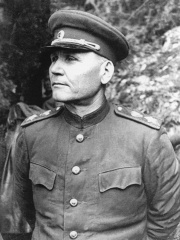
5. Ivan Konev (1897 - 1973)
With an HPI of 75.85, Ivan Konev is the 5th most famous Russian Military Personnel. His biography has been translated into 56 different languages.
Ivan Stepanovich Konev (Russian: Ива́н Степа́нович Ко́нев, IPA: [ɪˈvan sʲtʲɪˈpanəvʲɪtɕ ˈkonʲɪf]; 28 December 1897 – 21 May 1973) was a Soviet general and Marshal of the Soviet Union who led Red Army forces on the Eastern Front during World War II, responsible for taking much of Axis-occupied Eastern Europe. Born to a peasant family, Konev was conscripted into the Imperial Russian Army in 1916 and fought in World War I. In 1919, he joined the Bolsheviks and served in the Red Army during the Russian Civil War. After graduating from Frunze Military Academy in 1926, Konev gradually rose through the ranks of the Soviet military. By 1939, he had become a candidate to the Central Committee of the Communist Party. Following the German invasion of the Soviet Union in 1941, Konev took part in a series of major campaigns, including the battles of Moscow and Rzhev. Konev further commanded forces in major Soviet offensives at Kursk, in the Dnieper–Carpathian and Vistula–Oder offensives. In February 1944, he was made a Marshal of the Soviet Union. On the eve of German defeat, Konev's 1st Ukrainian Front was pitted against the armies of Georgy Zhukov in the Race to Berlin. Konev was the first Allied commander to enter Prague, the capital of Czechoslovakia, after the Prague uprising. He replaced Zhukov as commander of Soviet ground forces in 1946. In 1956, he was appointed commander of the Warsaw Pact armed forces, and led the violent suppression of the Hungarian Revolution and Prague Spring. In 1961, as commander of Soviet forces in East Germany, he ordered the closing of West Berlin to East Berlin during the building of the Berlin Wall. Konev remained a popular military figure in the Soviet Union until his death in 1973.

6. Alexander Suvorov (1730 - 1800)
With an HPI of 75.69, Alexander Suvorov is the 6th most famous Russian Military Personnel. His biography has been translated into 68 different languages.
Count Alexander Vasilyevich Suvorov-Rymniksky, Prince of Italy (24 November [O.S. 13 November] 1729 or 1730 – 18 May [O.S. 6 May] 1800) was a Russian general and military theorist in the service of the Russian Empire. Born in Moscow, he studied military history as a young boy and joined the Imperial Russian Army at the age of 17. Promoted to colonel in 1762 for his successes during the Seven Years' War, his victories during the War of the Bar Confederation included the capture of Kraków and victories at Orzechowo, Lanckorona, and Stołowicze. His reputation rose further when, in the Russo-Turkish War of 1768–1774, he captured Turtukaya twice and won a decisive victory at Kozludzha. After a period of little progress, he was promoted to general and led Russian forces in the Russo-Turkish War of 1787–1792, participating in the siege of Ochakov, as well as victories at Kinburn and Focșani. Suvorov won a decisive victory at the Battle of Rymnik, and afterwards decisively defeated the Ottomans in the storming of Izmail. His victories at Focșani and Rymnik established him as the most brilliant general in Russia, if not in all of Europe. In 1794, he put down the Polish uprising, defeating them at the battle of Praga and elsewhere. After Catherine the Great died in 1796, her successor Paul I often quarrelled with Suvorov. After a period of ill-favour, Suvorov was recalled to a field marshal position at the outbreak of the French Revolutionary Wars. He was given command of the Austro-Russian army, and after a series of victories, such as the battle of the Trebbia, he captured Milan and Turin, and nearly erased all of Napoleon's Italian conquests of 1796–97. After an Austro-Russian army was defeated in Switzerland, Suvorov, ordered to reinforce them, was cut off by André Masséna and later surrounded in the Swiss Alps. Suvorov's successful extraction of the exhausted, ill-supplied, and heavily-outnumbered Russian army was rewarded by a promotion to generalissimo (Russian: генералиссимус, romanized: generalissimus). The most prominent battle was in the Muottental. According to one statement, Masséna himself would later confess that he would exchange all of his victories for Suvorov's passage of the Alps; as per another, Masséna said that he would never forgive him for crossing won by him in Switzerland. Suvorov died in 1800 of illness in Saint Petersburg. He was instrumental in expanding the Russian Empire, as his success ensured Russia's conquering of Kuban, Crimea, and New Russia. He was one of the foremost generals in all of military history, and considered the greatest military commander in Russian history. Undefeated in major engagements, he has been described as the best general Republican France ever fought against, and noted as "one of those rare generals who were consistently successful despite suffering from considerable disadvantages and lack of support and resources." Suvorov was also admired by his soldiers throughout his whole military life, and was respected for his honest service and truthfulness.

7. Mikhail Tukhachevsky (1893 - 1937)
With an HPI of 74.93, Mikhail Tukhachevsky is the 7th most famous Russian Military Personnel. His biography has been translated into 50 different languages.
Mikhail Nikolayevich Tukhachevsky (Russian: Михаил Николаевич Тухачевский, romanized: Mikhail Nikolayevich Tukhachevskiy, IPA: [tʊxɐˈtɕefskʲɪj]; 16 February [O.S. 4 February] 1893 – 12 June 1937), nicknamed the Red Napoleon, was a Soviet general who was prominent between 1918 and 1937 as a military officer and theoretician. He was later executed during the Moscow trials of 1936–1938. He served as an officer in World War I of 1914–1917 and in the Russian Civil War of 1917–1923, leading the defense of the Moscow district (1918), commanding forces on the Eastern Front (1918), commanding the Fifth Army in the recapture of Siberia from Alexander Kolchak, and heading Cossack forces against Anton Denikin (1920). From 1920 to 1921 he commanded the Soviet Western Front in the Polish–Soviet War. Soviet forces under his command successfully repelled the Polish forces from Western Ukraine, driving them back into Poland, but the Red Army suffered defeat outside of Warsaw, and the war ended in a Soviet defeat. Tukhachevsky blamed Joseph Stalin for his defeat at the Battle of Warsaw. He later served as chief of staff of the Red Army from 1925 to 1928, as assistant in the People's Commissariat of Defense after 1934 and as commander of the Volga Military District in 1937. He achieved the rank of Marshal of the Soviet Union in 1935. As a major proponent of modernisation of Soviet armament and army force structure in the 1920s and 1930s, he became instrumental in the development of Soviet aviation, and of mechanized and airborne forces. As a theoretician, he was a driving force behind the Soviet development of the theory of deep operations in the 1920s and 1930s. Soviet authorities accused Tukhachevsky of treason, and after he confessed during torture, he was executed in 1937 during the military purges of 1936–1938, led by Stalin and Nikolai Yezhov.

8. Yevgeny Prigozhin (1961 - 2023)
With an HPI of 74.76, Yevgeny Prigozhin is the 8th most famous Russian Military Personnel. His biography has been translated into 78 different languages.
Yevgeny Viktorovich Prigozhin (1 June 1961 – 23 August 2023) was a Russian mercenary leader, rebel commander, and oligarch. He led the Wagner Group, a private military company, and was a close confidant of Russian president Vladimir Putin until launching a rebellion in June 2023. Prigozhin was sometimes referred to as "Putin's chef" because he owned restaurants and catering businesses that provided services to the Kremlin. Once a convict in the Soviet Union, Prigozhin controlled a network of influential companies whose operations, according to a 2020 investigation, were "tightly integrated with Russia's Defence Ministry and its intelligence arm, the GRU". In 2014, Prigozhin reportedly founded the Wagner Group to support Russian separatist forces in Ukraine. Funded by the Russian state, it played a significant role in Russia's invasion of Ukraine and supported Russian interests in Syria and in Africa. In November 2022, Prigozhin acknowledged his companies' interference in United States elections. In February 2023, he confirmed that he was the founder and long-time manager of the Internet Research Agency, a Russian company running online propaganda and disinformation campaigns. Prigozhin's companies and associates, and formerly Prigozhin himself, are subject to economic sanctions and criminal charges in the United States and the United Kingdom. In October 2020, the European Union (EU) imposed sanctions against Prigozhin for his financing of the Wagner Group's activities in Libya. In April 2022, the EU imposed further sanctions on him for his role in the Russian invasion of Ukraine. The FBI offered a reward of up to $250,000 for information leading to Prigozhin's arrest. Prigozhin openly criticized the Russian Defense Ministry for corruption and mishandling the war against Ukraine. Eventually, he said the reasons they gave for invading were lies. On 23 June 2023, he launched a rebellion against the Russian military leadership. Wagner forces captured Rostov-on-Don and advanced toward Moscow. The rebellion was called off the following day, and the criminal charges against Prigozhin were dropped after he agreed to relocate his forces to Belarus. On 23 August 2023, exactly two months after the rebellion, Prigozhin was killed along with nine other people when a business jet crashed in Tver Oblast, north of Moscow. The Wall Street Journal cited sources within the US government as saying that the crash was likely caused by a bomb on board or "some other form of sabotage". Since then, researchers and other analysts have reached the conclusion that an on-board bomb or explosive likely downed the plane.

9. Vasily Chuikov (1900 - 1982)
With an HPI of 74.13, Vasily Chuikov is the 9th most famous Russian Military Personnel. His biography has been translated into 51 different languages.
Vasily Ivanovich Chuikov (Russian: Василий Иванович Чуйков, Russian: [vɐˈsʲilʲɪj t͡ɕʉjkof] ; 12 February [O.S. 31 January] 1900 – 18 March 1982) was a Soviet military commander and Marshal of the Soviet Union. He is best known for commanding the 62nd Army which saw heavy combat during the Battle of Stalingrad in the Second World War and for being the commanding general to receive the surrender of the German troops defending Berlin. Born to a peasant family near Tula, Chuikov earned his living as a factory worker from the age of 12. After the Russian Revolution of 1917, he joined the Red Army and distinguished himself during the Russian Civil War. After graduating from the Frunze Military Academy, Chuikov worked as a military attaché and intelligence officer in China and the Russian Far East. At the outbreak of the Second World War, Chuikov commanded the 4th Army during the Soviet invasion of Poland, and the 9th Army during the Winter War against Finland. In December 1940, he was again appointed military attaché to China in support of Chiang Kai-shek and the Nationalists in the war against Japan. In March 1942, Chuikov was recalled from China to defend against the German invasion of the Soviet Union. By September, he was assigned command of the 62nd Army in defense of Stalingrad. Tasked with holding the city at all costs, Chuikov adopted keeping the Soviet front-line positions as close to the Germans as physically possible. This served as an effective countermeasure against the Wehrmacht's combined-arms tactics, but by mid-November 1942 the Germans had captured most of the city after months of slow advance. In late November Chuikov's 62nd Army joined the rest of the Soviet forces in a counter-offensive, which led to the surrender of the German 6th Army in early 1943. After Stalingrad, Chuikov led his forces into Poland during Operation Bagration and the Vistula–Oder Offensive before advancing on Berlin. He personally accepted the unconditional surrender of German forces in Berlin on 2 May 1945. After the war, Chuikov served as Chief of the Group of Soviet Forces in Germany (1949–53), commander of the Kiev Military District (1953–60), Chief of the Soviet Armed Forces and Deputy Minister of Defense (1960–64), and head of the Soviet Civil Defense Forces (1961–72). Chuikov was twice awarded the titles Hero of the Soviet Union (1944 and 1945) and was awarded the Distinguished Service Cross by the United States for his actions during the Battle of Stalingrad. In 1955, he was named a Marshal of the Soviet Union. Following his death in 1982, Chuikov was interred at the Stalingrad memorial at Mamayev Kurgan, which had been the site of heavy fighting.
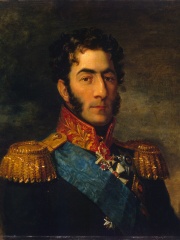
10. Pyotr Bagration (1765 - 1812)
With an HPI of 73.55, Pyotr Bagration is the 10th most famous Russian Military Personnel. His biography has been translated into 49 different languages.
Prince Pyotr Ivanovich Bagration (10 July 1765 – 24 September 1812) was a Russian general and prince of Georgian origin, prominent during the French Revolutionary and Napoleonic Wars. Bagration, a member of the Bagrationi dynasty, was born in Kizlyar. His father, Ivan (Ivane), served as an officer in the Imperial Russian Army, in which Bagration also enlisted in 1782. Pyotr Ivanovich Bagration began his military career serving in the Russo-Circassian War of 1763–1864. He later participated in a war against the Ottomans and the capture of Ochakov in 1788. Later, he helped suppress the Kościuszko Uprising of 1794 in Poland and capture Warsaw. During Russia's Italian and Swiss campaigns of 1799 against the French, he served with distinction under Field Marshal Alexander Suvorov. In 1805, Russia joined the coalition against Napoleon. After the collapse of the Austrians at Ulm in October 1805, Bagration won praise for his successful defense in the Battle of Schöngrabern (November 1805) that allowed Russian forces to withdraw and unite with the main Russian army of Mikhail Kutuzov. In December 1805, the combined Russo-Austrian army suffered defeat at the Battle of Austerlitz, where Bagration commanded the allied right wing against the French under Jean Lannes. He commanded Russian troops in the Finnish War (1808–1809) against Sweden and in another war against the Turks (1806–1812) on the Danube. During the French invasion of Russia in 1812, Bagration commanded one of two large Russian armies (Barclay de Tolly commanded the other) fighting a series of rear-guard actions. The Russians failed to stop the French advance at the Battle of Smolensk in August 1812. Barclay had proposed a scorched-earth retreat that the emperor Alexander I of Russia had approved, although Bagration preferred to confront the French in a major battle. Kutuzov succeeded Barclay as commander-in-chief but continued his policy until the Battle of Borodino (7 September [O.S. 26 August] 1812) near Moscow. Bagration commanded the left wing around what became known as the Bagration flèches at Borodino, where he was mortally wounded; he died two weeks later. Originally buried at a local church, in 1839 he was reburied on the battlefield of Borodino.
People
Pantheon has 169 people classified as Russian military personnels born between 1532 and 1993. Of these 169, 15 (8.88%) of them are still alive today. The most famous living Russian military personnels include Valery Gerasimov, Sergei Skripal, and Boris Gromov. The most famous deceased Russian military personnels include Vasily Zaitsev, Mikhail Kutuzov, and Stanislav Petrov. As of April 2024, 8 new Russian military personnels have been added to Pantheon including Aleksandr Lapin, Igor Kirillov, and Aleksandr Moiseyev.
Living Russian Military Personnels
Go to all RankingsValery Gerasimov
1955 - Present
HPI: 69.33
Sergei Skripal
1951 - Present
HPI: 67.38
Boris Gromov
1943 - Present
HPI: 62.59
Aleksandr Dvornikov
1961 - Present
HPI: 62.00
Oleg Kalugin
1934 - Present
HPI: 59.78
Sergey Surovikin
1966 - Present
HPI: 59.19
Oleg Salyukov
1955 - Present
HPI: 58.79
Viktor Zolotov
1954 - Present
HPI: 57.95
Aleksandr Lapin
1964 - Present
HPI: 52.58
Aleksandr Moiseyev
1962 - Present
HPI: 51.56
Leonid Khabarov
1947 - Present
HPI: 51.53
Vitaly Gerasimov
1977 - Present
HPI: 48.39
Deceased Russian Military Personnels
Go to all RankingsVasily Zaitsev
1915 - 1991
HPI: 81.62
Mikhail Kutuzov
1745 - 1813
HPI: 77.48
Stanislav Petrov
1939 - 2017
HPI: 76.92
Vasily Arkhipov
1926 - 1998
HPI: 75.89
Ivan Konev
1897 - 1973
HPI: 75.85
Alexander Suvorov
1730 - 1800
HPI: 75.69
Mikhail Tukhachevsky
1893 - 1937
HPI: 74.93
Yevgeny Prigozhin
1961 - 2023
HPI: 74.76
Vasily Chuikov
1900 - 1982
HPI: 74.13
Pyotr Bagration
1765 - 1812
HPI: 73.55
Semyon Budyonny
1883 - 1973
HPI: 72.85
Felix Steiner
1896 - 1966
HPI: 72.47
Newly Added Russian Military Personnels (2025)
Go to all RankingsAleksandr Lapin
1964 - Present
HPI: 52.58
Igor Kirillov
1970 - 2024
HPI: 51.95
Aleksandr Moiseyev
1962 - Present
HPI: 51.56
Roman Kutuzov
1969 - 2022
HPI: 48.42
Alexander Zhuravlyov
1965 - Present
HPI: 46.50
Denis Kapustin
1984 - 2025
HPI: 45.39
Alexey Milchakov
1991 - Present
HPI: 42.44
Alexander Prokhorenko
1990 - 2016
HPI: 37.94
Overlapping Lives
Which Military Personnels were alive at the same time? This visualization shows the lifespans of the 25 most globally memorable Military Personnels since 1700.

